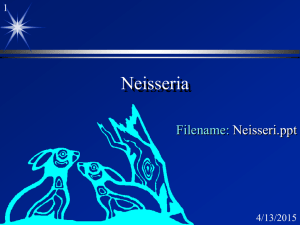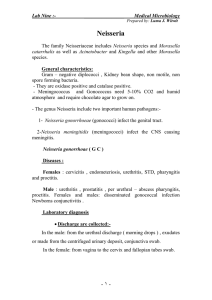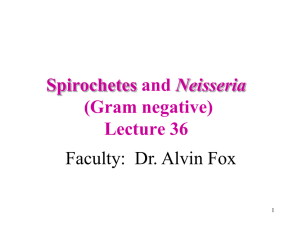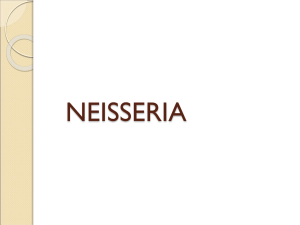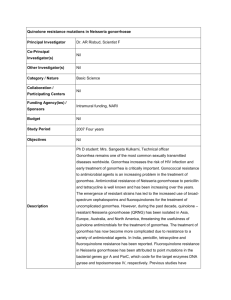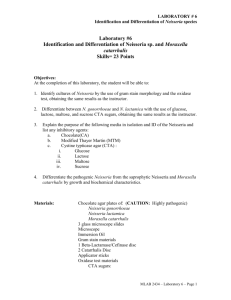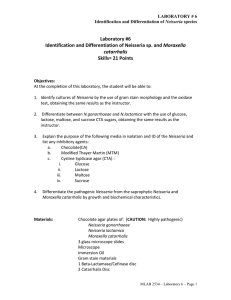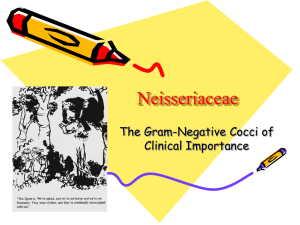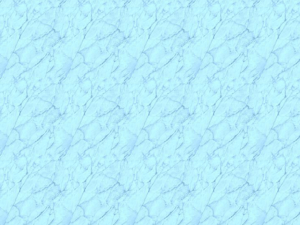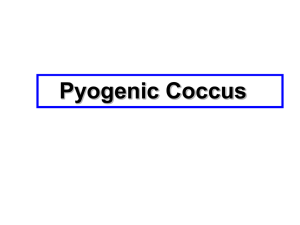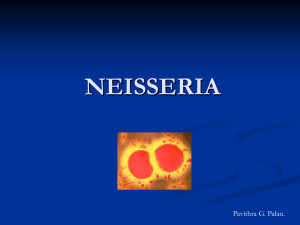CLSC 3033 MEDICAL MICROBIOLOGY
advertisement
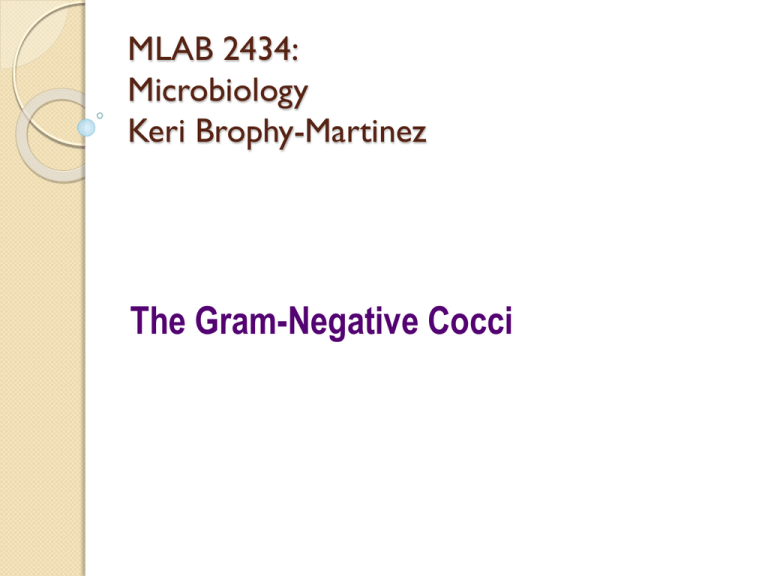
MLAB 2434: Microbiology Keri Brophy-Martinez The Gram-Negative Cocci Families Neisseriaceae ◦ ◦ ◦ ◦ ◦ Neisseria Kingella Eikenella Simonsiella Alysiella Moraxellaceae ◦ Moraxella ◦ Acinetobacter General Characteristics: Neisseria Species Aerobic, gram-negative diplococci Nonmotile Oxidase positive Catalase positive Fastidious, capnophilic Neisseria Species and Moraxella catarrhalis Habitat ◦ Upper respiratory tract ◦ Genitourinary tract ◦ Alimentary(Digestive) tract Primary pathogens: ◦ N. gonorrhoeae ◦ N. meningitidis Virulence Factors Fimbrae (common pili)◦ enhance the ability of bacterial cells to adhere to host cells and to each other Lipooligosaccharide: ◦ endotoxin involved in damage to host tissue Capsule Cell membrane proteins IgA protease◦ cleaves IgA on mucosal surfaces Clinical Conditions: Neisseria gonorrhoeae Pyogenic (pus-producing) infection of columnar and transitional epithelial cells ◦ urethral, endocervix, anal canal, pharynx, and conjunctiva Incubation period: 2 to 7 days Transmitted by sexual contact Clinical Infections: Neisseria gonorrhoeae Disease in the male Disease in the female ◦ 95% show symptoms of acute infection ◦ 20% to 80% are asymptomatic ◦ Symptoms include dysuria, urethral discharge ◦ Symptoms include: Burning or frequency of urination, vaginal discharge, fever and abdominal pain ◦ Complications include epididymitis and urethral stricture, and prostatitis ◦ Complications include pelvic inflammatory disease (PID), sterility and ectopic pregnancy Clinical Conditions: Neisseria gonorrhoeae: Disseminated gonococcal disease ◦ Acute form has the following symptoms: fever, chills, malaise, intermittent bacteremia, and skin lesions ◦ If untreated will progress to septic joint form of the disease (inflamed joints, swollen, hot, full of pus and fluid) ◦ Gonococcal arthritis occurs as a result of disseminated gonococcal bacteremia Clinical Conditions: Neisseria gonorrhoeae: Disease in children ◦ In infancy, an eye infection (ophthalmia neonatorum) may occur during vaginal delivery ◦ May cause blindness if not treated ◦ Infection is preventable with the application of antibiotic eye drops at birth Extragenital infections ◦ Pharyngitis ◦ Anorectal infections Laboratory Diagnosis: Neisseria gonorrhoeae Clinical specimens ◦ Genital sites Female: endocervix Male: urethra ◦ Anal ◦ Oral/pharyngeal ◦ Eye ◦ Blood/joint fluids Specimen Collection ◦ Dacron/ Rayon swabs preferred ◦ Swabs transported in Amies medium with charcoal ◦ Inoculate media within 6 hours of collection, avoid drying Transport Media Transgrow or JEMBEC JEMBEC= James E Martin Biological Environmental Chamber JEMBEC Laboratory Diagnosis: Neisseria gonorrhoeae Morphology ◦ Gram-negative, kidneybean–shaped diplococci Laboratory Diagnosis: Neisseria gonorrhoeae Media Selection Chocolate agar ◦ Subject to overgrowth of normal flora Thayer-Martin agar is chocolate agar with vancomycin, colistin, and nystatin MTM contains the above plus trimethoprin Specimen MUST be plated on warmed media ASAP Incubation Inoculated culture media must be incubated at 350 C in 3% to 5% CO2 or candle jar Candle jar must use white wax candles Laboratory Diagnosis: Neisseria gonorrhoeae Colony morphology on modified Thayer-Martin (MTM) agar ◦ Small, beige- gray ◦ Translucent, smooth Fresh growth must be used for testing, because N. gonorrhoeae produces autolytic enzymes Laboratory Diagnosis: Neisseria gonorrhoeae ◦ Oxidase Test Test on filter paper or directly on plate Oxidase reagent =Dimethyl or tetramethyl oxidase reagent Violet-purple color indicates a positive result Laboratory Diagnosis: Neisseria gonorrhoeae Carbohydrate utilization Cystine trypticase agar (CTA) ◦ Contain 1% of a single carbohydrate Glucose, maltose, lactose, sucrose ◦ Phenol red is pH indicator Read in 24-72 hours Laboratory Diagnosis: Neisseria gonorrhoeae Immunologic methods ◦ Use colonies from primary plate ◦ Organisms do not need to be viable Fluorescent antibody technique Coagglutination Non-culture methods ◦ Use direct patient specimen ◦ ELISA, nucleic acid probe, and PCR testing ◦ Expensive; usually used in high-risk populations with large volume of testing ◦ Unable to perform on all sources Antimicrobial Resistance: Neisseria gonorrhoeae PPNG = Penicillinase Producing Neisseria gonorrhoeae ◦ First seen in 1976 ◦ Plasmid-mediated ◦ Beta-lactamase testing should always be done on N. gonorrheoae Treatment = Penicillin Tetracycline if beta-lactamase positive strain. Can also use cephalosporins and flouroquinolones Neisseria meningitidis Commensal of carriers in the nasopharynx Cross the epithelium and enter the circulatory system ◦ Primarily affects the immunocompromised, young children, trauma victims Leads to septicemia and localization to the meninges causing inflammation of the brain Meningitis Highly fatal (25% even if treated) ◦ Encapsulated strains A, B, C,Y, W-135 Virulence Factors: Neisseria meningitidis Pili Polysaccharide capsule Cellular membrane proteins Lipooligosaccharide/endotoxin Clinical Infections: Neisseria meningitidis: Bacterial meningitis ◦ Transmission is by respiratory droplets and requires both close contact (ex: dormitories, military barracks, in institutions) and lack of specific antibody (susceptibility) ◦ Symptoms include fever, headache, stiff neck, nausea, vomiting, and purulent meningitis with increased WBCs ◦ Serotypes B and C most common in US Other infections include meningococcemia, pneumonia, purulent arthritis, & endophthalmitis May be seen in genital tract with oral-genital contact Clinical Infections: Neisseria meningitidis Hemorrhage in the adrenal glands in WaterhouseFridericksen syndrome Laboratory Diagnosis: Neisseria meningitidis Identification ◦ Examine direct smear from CSF for intra & extra cellular g- dc ◦ Examine smear for halo ◦ Other body sites include nasopharyngeal swabs, sputum, and urogenital specimens Gram-stained smear of CSF showing the extra cellular and intracellular gram-negative diplococci Laboratory Diagnosis: Neisseria meningitidis Examine cultures on blood agar & chocolate agar after incubation in increased CO2 Colony Morphology ◦ Small ◦ Tan-grey color ◦ Smooth Neisseria meningitidis growing on sheep blood agar (right) and chocolate agar (left) Laboratory Diagnosis: Neisseria meningitidis ◦ Oxidase-test positive ◦ Conventional CTA carbohydrates for biochemical identification (glucose+ and maltose+) ◦ Immunologic methods Antibiotic Therapy: Neisseria meningitidis Penicillin Other options: rifampin or sulfonamide Vaccine ◦ For use with people aged 11-55 ◦ Does not protect against all serotypes Nonpathogenic Neisseria species Normal flora of upper respiratory tract Some members ◦ ◦ ◦ ◦ ◦ Neisseria cinera Neisseria lactamica Neisseria mucosa Neisseria sicca Neisseria subflava Moraxella catarrhalis Previously known as Branhamella catarrhalis Normal commensal of the respiratory tract Has become an important opportunistic pathogen ◦ Predisposing factors Advanced age, Immunodeficiency, Neutropenia, Other debilitating diseases Clinical infections ◦ Pneumonia ◦ Sinusitis ◦ Otitis media (3rd most common cause) Virulence factors: Moraxella catarrhalis Endotoxin Pili Beta-lactamase Laboratory Diagnosis: Moraxella catarrhalis Direct smear from an otitis media sample showing intracellular gram-negative diplococci Laboratory Diagnosis: Moraxella catarrhalis Colonies appear smooth with a grayishwhite color When colonies pushed with loop, they “scoot” across media Moraxella catarrhalis growing on chocolate agar after 24 hours of incubation Laboratory Diagnosis : Moraxella catarrhalis Oxidase positive Catarrhalis Disc ◦ Positive= blue-gren All CTA sugars negative Produce beta- lactamase Identification of Selected Neisseria Species & Moraxella Species BAP Growth R.T T/M Acid production Gluc Mal Lac Suc N. gonorrhoeae =/+ = + + = = = N. meningitidis + = + + + = = N. lactamica + v + + + + = N. sicca + + = + + = + M. catarrhalis + + = = = = = References Engelkirk, P., & Duben-Engelkirk, J. (2008). Laboratory Diagnosis of Infectious Diseases: Essentials of Diagnostic Microbiology . Baltimore, MD: Lippincott Williams and Wilkins. http://www.awinhospitalproducts.com/product/35collection-swab-amies-medium-w-charcoal-wwcsam-3450 https://new.fishersci.com/ecomm/servlet/fsproductdetail_10 652_606366_29104_-1_0 https://picasaweb.google.com/pia8628/0411microlab#559610 4725803822690/ Mahon, C. R., Lehman, D. C., & Manuselis, G. (2011). Textbook of Diagnostic Microbiology (4th ed.). Maryland Heights, MO: Saunders.

